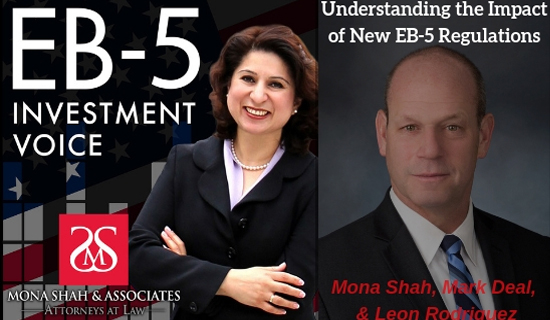
Understanding the Impact of New EB-5 Regulations with Former USCIS Director Leon Rodriguez – Episode 81
How will the new DHS rules regarding investment thresholds and TEA designation shift the EB-5 industry long-term? In this episode, Mona and Mark are joined by Leon Rodriguez, former Director of USCIS, to discuss the timing of the new regulations and the impact they may have on the industry moving forward. Listen in for Leon’s insight around how the investor profile is likely to change and why a realignment of EB-5 may not be such a bad thing.
Since the Department of Homeland Security (DHS) issued new EB-5 regulations, industry stakeholders have been trying to make sense of the timing and considering how the rules will impact the industry long-term. Will the increase in minimum investment influence the type of foreign investor who pursues EB-5? Will the new Target Employment Area (TEA) framework really give poor municipalities a greater foothold in the program? Will changes to TEA expand the range of industries that engage in EB-5?
Leon Rodriguez served as Director of US Citizenship and Immigration Services (USCIS) from 2014 through 2017, following a 25-year career as an attorney, prosecutor and government agency leader. On this episode of EB-5 Investment Voice, he joins Mona and Mark to discuss the rationale around the timing of the new EB-5 regulations, explaining why USCIS may have published the rules just weeks before potential draft legislation.
Leon addresses how the change in TEA designation will impact projects and weighs in on the trends around processing times and concurrent filings. Listen in to understand how the regulations might facilitate a realignment of the EB-5 program, shifting the investor profile and perhaps ushering in a new class of entrepreneurs from a wide variety of industries.
The Rationale Around Timing
- Many industry players question the timing of the new EB-5 regulations, considering that draft legislation is due to come out at the end of September. Leon suggests that the new rules might serve as a kind of insurance policy for USCIS, issued now precisely because of the potential for a deal between Capitol Hill and EB-5 interests.
- Leon also believes that the four-month window before the regulations go into effect affords room for legislative jockeying to occur. This is likely a strategic move on the part of USCIS, as a bill would supersede these new DHS rules.
How the TEA Issue Impacts Projects
- According to USCIS, 53% of the current projects will be affected by the new rules around TEA designation. Leon cites correspondence between Senator Chuck Grassley and DHS as the impetus behind this particular change to the program.
- Giving DHS the power to define TEA is designed to end gerrymandering and shift the economic benefit of EB-5 to truly distressed areas. Mona argues that a more nuanced view of how the economic benefit is created may be necessary and expresses concern that developers will abandon the program as a result of the TEA issue.
A New Kind of EB-5 Investor?
- Mona points out that under the new rules, only ten jobs will be created for every $2M in investment. Leon explains that the impetus for raising the minimum investment threshold was not to change the investor profile, but simply to reflect inflation.
- Leon suggests that the industry had already made peace with the increase in minimum investment and contends that the type of foreign investor who pursues EB-5 had already begun to shift. He is interested to see if more Latin American investors will take advantage of the program moving forward due to political instability that part of the world.
Trends Around Processing Times & Concurrent Filings
- EB-5 adjudications have experienced a significant slow-down in the last six months, but Leon doesn’t think this is necessarily tied to the regulations. In fact, AILA testimony states that 96% of all USCIS categories are experiencing substantially more backlog than two years ago. Leon points to an increase in anti-fraud measures and greater scrutiny of applications as two of the factors contributing to the increase in processing times.
- Leon suggests that there is also a general trend away from concurrent filings, despite the efficiencies that could be realized with such an allowance. He contends that the current administration seems intent on making things more difficult for EB-5 investors at every turn.
The Realignment of EB-5
- In the short term, Leon believes that the new regulations will trigger a spike in activity as developers work to get projects fully subscribed prior to the November 21 effective date. In the long term, the changes may lead to a full realignment of the industry.
- Mona and Leon speculate that with under the new rules, EB-5 will no longer serve as an alternative source of capital for real estate and construction projects in large cities like New York and Miami. But the new TEA framework is likely to usher in a new class of entrepreneurs from other industries (i.e.: technology, pharmaceuticals, etc.).
- Leon suggests that local governments could become far more involved in EB-5. In fact, poor municipalities with a TEA designation would benefit from setting up a Regional Center and marketing opportunities to investors around the world.
- As long as EB-5 continues to provide cheap capital, the program will continue to thrive. Leon and Mona hope that as the industry evolves to become more global, we will realize its full economic benefit.
